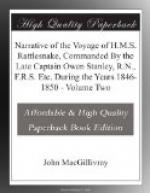About eight days after, Jackey-Jackey, having with wonderful ingenuity succeeded in escaping from his pursuers, contrived to reach Port Albany, and was received on board the vessel, which immediately proceeded to Shelburne Bay to endeavour to rescue the three men left there. The attempt to find the place was unsuccessful, and from the evidence furnished by clothes said by Jackey to belong to them, found in a canoe upon the beach, little doubt seemed to exist as to their fate. They then proceeded to Weymouth Bay, where they arrived just in time to save Mr. Carron, the botanical collector, and another man, the remaining six having perished. In the words of one of the survivors: “the men did not seem to suffer pain, but withered into perfect skeletons, and died from utter exhaustion.”
Such was the fate of Kennedy’s expedition, and in conclusion, to use the words of the Sydney Morning Herald, “it would appear that as far as earnestness of purpose, unshrinking endurance of pain and fatigue, and most disinterested self-sacrifice, go, the gallant leader of the party exhibited a model for his subordinates. But the great natural difficulties they had to encounter at the outset of the expedition so severely affected the resources of the adventurers, that they sunk under an accumulation of sufferings, which have rarely, if ever been equalled, in the most extreme perils of the wilderness.”
SAIL ON OUR SECOND NORTHERN CRUISE.
Our stay in Sydney was protracted to the unusual period of three months and a half, affording ample time for refreshing the crews after their long and arduous labours, thoroughly refitting both vessels, and completing the charts. The object of our next cruise, which was expected to be of equal duration with the last, was to undertake the survey of a portion of the Louisiade Archipelago, and the south-east coast of New Guinea. For this purpose we sailed from Sydney on May 8th, deeply laden, with six months provisions on board, arrangements having also been made for receiving a further supply at Cape York in October following.
The Bramble joined us at Moreton Bay, where we did not arrive until May 17th, our passage having been protracted beyond the usual time by the prevalence during the early part of light northerly winds and a strong adverse current, which on one occasion set us fifty-one miles to the southward in twenty-four hours. We took up our former anchorage under Moreton Island, and remained there for nine days, occupied in completing our stock of water, and obtaining a rate for the chronometers—so as to ensure a good meridian distance between this and the Louisiade. Since our last visit, the pilot station had been shifted to this place from Amity Point, the northern entrance to Moreton Bay being now preferred to that formerly in use.




